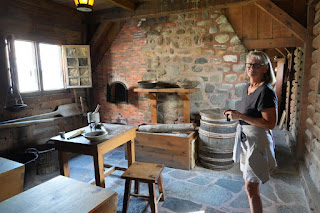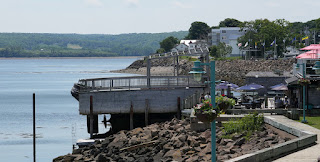We woke up to some thick fog and saw something I'm not sure I've seen before - a fogbow! It was sunlight reflected off of the fog so it was exactly opposite the direction of the rising sun.
It was low tide so we walked to the wharf we saw on moving day to have a look. The three boats in yesterday's picture were out fishing and we were looking 25 feet down to the seabed. To contrast, I tried to take the same pictures at high tide the next day.
Fantasy arranged a lunch at a German restaurant in Annapolis Royal. We had our choice of Schnitzel or Bratwurst. Joani had the brat and I had the schnitzel and we shared. I think the schnitzel was delicious and my favorite. Blueberry crumble was served with ice cream for dessert.
Our host, the pastry chef, was from East Germany (her husband was the cook and her daughter was one of the servers). She talked for a few minutes about her history and how they ended up in Canada. She was passionate about what she sees happening to Canada now and the parallels with what she lived through in East Germany. She did not get the memo about no political discussions.
After we finished, Steve, the tour wagon master, tried to round everyone up for a group photo. Talk about herding cats.
He did get everyone still for a few moments, but we have yet to see the picture so I have no idea if he was successful. I cannot imagine everyone was visible in the picture but maybe he will share it later.
The fog was long gone and the sun was brightly shining. It was a beautiful day for another walk around Annapolis Royal. We started with Fort Anne.
The museum, housed in the last remaining building in the fort, had a model to help visualize the entire fort in its prime.
In a cutaway of the building's wall, we could see how bricks had been used to fill in around the timber framing. Using building materials from older buildings was referred to as "bricknogging".
There was a picture of Queen Elizabeth sewing a few stitches in the tapestry of her great-grandmother, Queen Anne.
Later in the evening we sat around a fire and watched the sunset. Clouds rolled in before it sank below the horizon but we did get to see some nice color even if we didn't see the actual sunset.
The fog rolled rolled in and then it rolled back out again.
Jean, Brian, Jean, Randy and Joani
Jean and Randy's fur baby, Sheldon.
As night fell, we watched a fishing boat work the shoreline.
It gets dark pretty late at these latitudes in the summer so it was time to call it a night after a long and eventful day.



































































